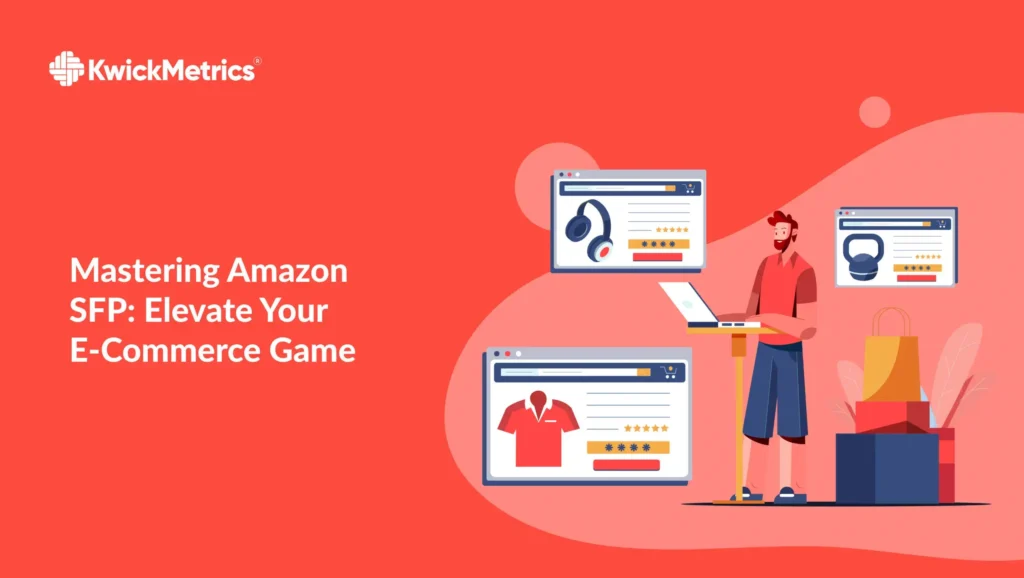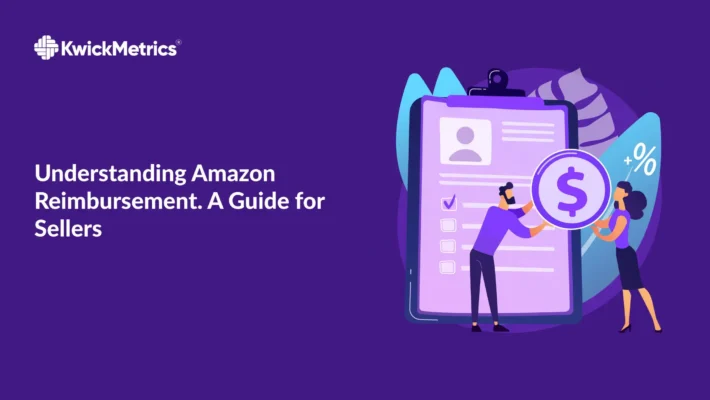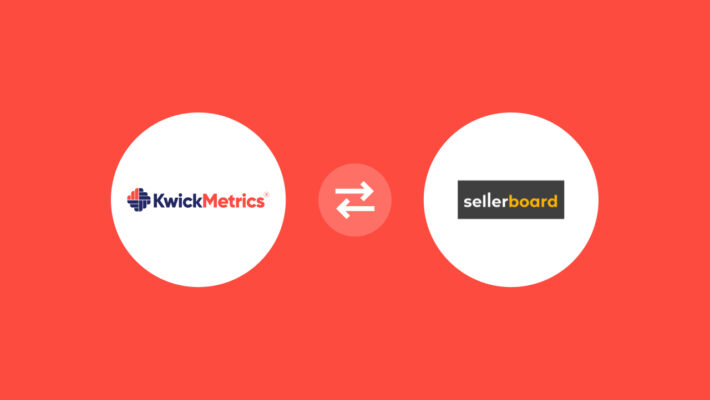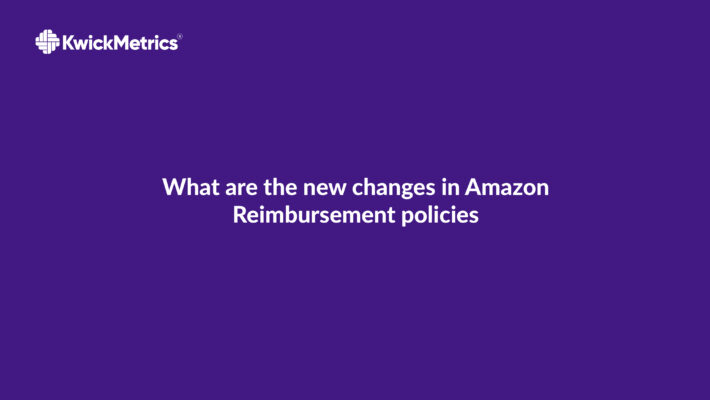Mastering Amazon SFP: Elevate Your E-Commerce Game

Table of Contents
- What is Seller Fulfilled Prime (SFP)?
- The Game-Changing Influence of Amazon SFP
- Amazon SFP: Winning Strategies for Sellers
- Meeting Amazon SFP Requirements: Your Path to Prime Excellence
- Boost Your Sales With KwickMetrics
- The SFP Story: Amazon’s Prime Evolution
- FBA vs. SFP: Decoding Amazon’s Fulfilment Divergence
- Enroll in SFP: Your Easy Ticket to Prime Visibility
- KwickMetrics - The Business Intelligence and Analytics Tool
- SFP Assurance: Securing Prime Standing Effortlessly
- Advantages of using Amazon Seller-Fulfilled Prime:
- Try our Amazon Analytics Tool with a 14-day Free Trial!
- Drawbacks of using Amazon Seller-Fulfilled Prime:
- Frequently asked questions (FAQs)
- Conclusion
In the competitive realm of e-commerce, aligning your business with Amazon Prime can be a game-changer. Amazon SFP (Seller Fulfilled Prime) program offers an enticing avenue for high-volume sellers to tap into the coveted Prime shelves.
In this comprehensive guide, we will delve into the intricacies of Amazon SFP, explore its requirements, differentiate it from Fulfilment by Amazon (FBA), and provide strategies to thrive in this dynamic program.
What is Seller Fulfilled Prime (SFP)?
Seller Fulfilled Prime (SFP), introduced by Amazon in 2015, reopened its doors on October 1, 2023, after a temporary suspension.
Amazon Seller Fulfilled Prime (SFP) is a specialized order fulfilment program, allowing high-volume sellers to list their products under the Prime label and to take charge of their packing, shipping, and storage processes, offering customers the benefits of one-day and two-day Prime shipping.
The Pause and Refinement
Temporarily suspended post-launch, SFP underwent refinement, ensuring alignment with Prime service standards. The hiatus aimed at enhancing the program for both sellers and customers.
The Grand Reopening – October 1, 2023
Amazon’s official reopening of SFP in 2023 marked a significant moment for sellers, offering renewed opportunities to showcase the Amazon Prime Badge and take control of their fulfilment processes.
The Game-Changing Influence of Amazon SFP
Increased Margins and Profitability
SFP Amazon allows sellers to optimize their catalog by using a combination of FBA and SFP, maximizing margins and profits across different types of SKUs.
Access to Prime Customer Base
By offering Prime shipping, even for specific merchant-fulfilled SKUs, sellers enhance conversion rates and tap into the vast pool of 150 million US Prime members.
Centralized Inventory Management
SFP extends benefits beyond Amazon, enabling sellers to develop logistics systems outside of FBA. This centralized approach proves invaluable when expanding to other channels, eliminating redundancies and streamlining operations.
Competitive Advantage in Buy Box
Products listed with the Amazon Prime badge, whether FBA or SFP, have increased chances of winning the Buy Box. This advantage positions sellers favorably against non-Prime offers.
Flexible Inventory Control
SFP provides sellers with more control and insight over their Amazon inventory by keeping operations in one location. This flexibility helps avoid stock outs and lag time associated with FBA.
Key Takeaway:
Leverage Seller Fulfilled Prime (SFP) to gain control over branding, tap into the vast Prime customer base, and increase sales with the trusted Prime badge. Balance the advantages of SFP, such as flexible inventory control and competitive Buy Box positioning, against the associated challenges and costs.
Amazon SFP: Winning Strategies for Sellers
Great Technology is Vital: With the shift to ‘On Time Delivery’ metrics, intelligent shipping software becomes crucial for cost optimization and meeting Amazon Seller Fulfilment Prime requirements. It automates fulfilment location comparison, carrier selection, and shipping service choices.
Multiple Warehouses in the Right Locations: SFP success requires strategically located warehouses to fulfil the promise of one-day delivery. The nuanced relationship between warehouse count, population coverage, and delivery promises adds complexity, making strategic warehouse placement essential.
Choose Data-Driven Fulfilment Partners: Selecting a fulfilment partner with data-driven analysis capabilities ensures accurate cost comparisons and deep expertise in SFP. Social proof and positive Seller Central reviews contribute to making an informed choice.
Offer Fast Deliveries: SFP demands fast, reliable deliveries. Meeting the strict performance requirements consistently is essential to maintain eligibility and enjoy the benefits of the Prime badge.
Key Takeaway:
Implement winning strategies, including adopting cutting-edge technology, strategically locating warehouses, and choosing data-driven fulfillment partners for SFP success. Comply with stringent SFP requirements during the trial period to secure Prime eligibility and activate the coveted Prime badge on product listings.
Meeting Amazon SFP Requirements: Your Path to Prime Excellence
Eligibility Criteria for SFP
SFP isn’t accessible to all sellers; strict eligibility criteria ensure that only top-tier sellers can qualify. To enroll, sellers must pass a trial period and meet Premium Shipping requirements.
Trial Period and Its Importance
The trial period, lasting 5 to 90 days with a minimum of 200 orders, is a crucial phase. During this time, sellers must maintain high-performance percentages to qualify for the SFP program.
Premium Shipping Requirements
Before enrolling in SFP, sellers must showcase their ability to provide consistent Premium Shipping services, including a valid tracking rate of 99%, on-time delivery rate of 97%, and a cancellation rate of 0.5% or less.
Boost Your Sales With KwickMetrics
Explore 14-day free trial! No credit card required, cancel at any time.
The SFP Story: Amazon’s Prime Evolution
Understanding Amazon’s Customer-Centric Approach: Amazon’s commitment to customer satisfaction drives initiatives like SFP. The program aims to ensure reliable and quick order fulfilment, expand product choices, and eliminate extra shipping costs for customers.
Goals Behind Introducing SFP: By launching SFP, Amazon sought to enhance customer experience, particularly for Prime subscribers. The program enables customers to receive orders swiftly without incurring additional shipping charges.
FBA vs. SFP: Decoding Amazon’s Fulfilment Divergence
| SFP | Own Shipping | FBA |
|---|---|---|
| Prime Badge | Yes | No |
| FBA Fee | No | No |
| Buy Box Perk | Yes | No |
| Customer Service | Amazon | Seller |
| Control Over Shipping | Some | Complete |
| Shipping Performance | Too High | High |
| Own Shipping Operation | Yes | Yes |
| Who Pays for Shipping? | Seller | Seller gets to choose |
Prime Badge and Its Implications: Both FBA and SFP offer the coveted Prime Badge, but the key difference lies in shipping. SFP sellers fulfil orders and pay for shipping, while FBA sellers enjoy Amazon handling shipping at a fee.
Cost Considerations: FBA Fees vs. SFP Expenses: While FBA may incur higher fees, SFP allows sellers to exclude FBA shipping, storage fees, and handling. Sellers need to weigh the cost-effectiveness based on their product type and business model.
Control Over Shipping and Customer Service Variations: SFP grants sellers more control over their fulfilment process, including branding and inventory visibility. However, customer service is handled by the seller, differentiating it from FBA’s reliance on Amazon for customer inquiries.
Key Takeaway:
Understand the key differences between Fulfillment by Amazon (FBA) and Seller Fulfilled Prime (SFP) in terms of shipping, costs, and control over the fulfillment process. Make an informed decision based on business goals and customer expectations, recognizing the trade-offs between FBA's convenience and SFP's autonomy.
Enroll in SFP: Your Easy Ticket to Prime Visibility
Premium Shipping Prerequisites: Before SFP enrollment, sellers must qualify for Premium Shipping by maintaining high performance in tracking, delivery, and cancellation metrics over a 30-day period.
Enrolling in the SFP Program: Sellers can enroll in SFP through Seller Central, assigning items to the “Prime trial” shipping template. Only items in this template contribute to trial performance measurement.
Navigating the Trial Period Successfully: The trial period, ranging from 5 to 90 days, requires sellers to maintain overall high performance. Upon successful completion, the Prime Badge is activated on their product listings.
KwickMetrics - The Business Intelligence and Analytics Tool
How to Enroll in Seller Fulfilled Prime?
Enrollment for Amazon Seller-Fulfilled Prime Program reopened in 2023. The process involves:
-
- Visit the Seller-Fulfilled Prime Landing Page: Navigate to the Seller-Fulfilled Prime landing page on Amazon.
-
- Join the Waitlist: Click on “Join the waitlist“ and follow the prompts in your Seller Central account to express your interest in participating in the SFP program.
How does Seller fulfilled Prime Work?
To become eligible for SFP amazon, sellers undergo a trial period lasting from five to 90 days, during which they must fulfil at least 100 Prime packages, meeting Amazon’s stringent shipping requirements.
The trial mandates offering Premium One-Day to Two-Day delivery options without the Prime badge being displayed. After successfully completing the trial, sellers are automatically enrolled in amazon Seller Fulfilment Program, and their listings showcase the Amazon Prime badges.
SFP Assurance: Securing Prime Standing Effortlessly
Critical Metrics: Sellers must vigilantly monitor metrics such as timely shipment rate, valid tracking rate, and cancellation rate. Failure to meet SFP requirements can result in the suspension of the Prime Badge.
Actions for Suspension: If SFP is suspended, sellers need to address issues promptly. The latest requirements include maintaining a timely delivery rate of 97% or higher for Premium Shipping orders and a 99% timely shipment rate for SFP.
Premium Shipping vs. SFP Requirements Comparison: Distinguishing between Premium Shipping and SFP, sellers must align with specific metrics to ensure the uninterrupted activation of Prime Badges.
Exploring Fulfilment Alternatives for SFP Sellers:
Utilize FBA or Switch Back to FBM (Without Prime Shipping): Sellers facing challenges with SFP requirements can consider reverting to Fulfilment by Amazon (FBA) or Fulfilment by Merchant (FBM) without offering Prime shipping.
Utilize Third-Party Fulfilment Centers Specializing in SFP Orders: Third-party fulfilment centers that specialize in SFP orders provide an alternative solution for sellers seeking efficient and reliable fulfilment services.
Getting Ready for SFP Excellence:
Prepare your business for SFP by setting up Fulfilment by Merchant (FBM) offers and ensuring that your fulfilment processes align with Amazon’s requirements. Navigating SFP successfully can create a potent competitive advantage for your brand on the Amazon platform.
Advantages of using Amazon Seller-Fulfilled Prime:
Increases Sales & Profits with the Trusted Prime Badge: Activation of the Prime Badge boosts visibility and credibility.
Less Expensive Compared to FBA: Excludes FBA fees, making it more cost-effective for certain sellers.
Use Amazon’s Customer Support Service: Access to Amazon’s customer support 24/7.
Access to Amazon’s Prime Customer Base: Sellers gain the opportunity to tap into Amazon’s vast Prime customer base, comprising 150 million members. This can significantly boost product visibility and sales.
No FBA Fees or Storage Fees: Unlike Fulfilment by Amazon (FBA), SFP eliminates the associated fees, allowing sellers to potentially increase profitability by saving on fulfilment costs.
Increased Chances to Win the Buy Box: Products listed with the Amazon seller Prime badge have a competitive edge in winning the Buy Box, enhancing the likelihood of customers choosing your product over others.
Control Over Branding and Inventory:
Sellers leveraging Seller Fulfilled Prime (SFP) gain autonomy in branding and inventory management, fostering a unique brand identity. Opting for SFP over Fulfillment by Amazon (FBA) allows greater control, steering clear of challenges tied to Amazon’s fulfillment centers.
Try our Amazon Analytics Tool with a 14-day Free Trial!
Drawbacks of using Amazon Seller-Fulfilled Prime:
Strict Standards to Maintain SFP Status: Compliance with stringent SFP standards is essential. Falling short of these requirements can result in the loss of Prime eligibility for listings.
Costs Associated with Storing and Shipping Items: While SFP eliminates certain Amazon fees, sellers incur costs related to storing inventory, shipping items, and meeting the program’s fast delivery promises.
Handling Returns Independently: Unlike FBA, where Amazon manages returns, SFP sellers must handle returns independently, requiring efficient processes and storage capabilities.
Additional 2% Fee on SFP Orders: Starting October 1, 2023, Amazon introduced an extra 2% fee on all SFP orders, impacting the overall cost structure for sellers in the program.
Frequently asked questions (FAQs)
What is Seller Fulfilled Prime (SFP) on Amazon?
SFP is a program that allows high-volume sellers to handle their own packing, shipping, and storage processes, offering customers one-day and two-day Prime shipping benefits.
How does SFP differ from Fulfilment by Amazon (FBA)?
While FBA involves Amazon handling shipping and storage for sellers, SFP sellers manage these processes independently, gaining more control over branding and inventory.
What are the eligibility criteria for enrolling in Seller Fulfilled Prime?
Top-tier sellers must pass a trial period, fulfilling a minimum of 200 orders with high-performance percentages and meeting Premium Shipping requirements.
What advantages does SFP offer, and how can sellers succeed in the program?
SFP provides control over branding, access to the Prime customer base, and a competitive edge in the Buy Box. Success involves technology adoption, strategic warehouse placement, and data-driven partners.
What are the key considerations for sellers deciding between FBA and SFP?
SFP offers cost advantages and control, while FBA provides convenience and Amazon-backed customer service. The choice depends on business goals and customer expectations.
Conclusion
In the ever-evolving landscape of e-commerce, Amazon continues to revolutionize market dynamics. For sellers, meeting customer expectations is paramount, and options like FBA and SFP facilitate this goal.
Choosing between FBA and SFP hinges on product types and business operations.
While SFP offers control and cost advantages, FBA provides convenience and Amazon-backed customer service.
Ultimately, the decision rests on aligning with your business goals and customer expectations, ensuring a successful journey in the competitive realm of Amazon Prime.


